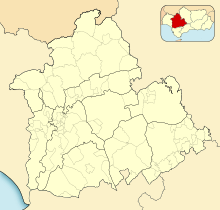Battle of Écija (1275)
| Battle of Écija | |||||||
|---|---|---|---|---|---|---|---|
| Part of the Reconquista | |||||||
 Farmland near Écija near the spot where Nuño González de Lara was killed and decapitated. | |||||||
| |||||||
| Belligerents | |||||||
| Kingdom of Castile |
Marinid Dynasty Emirate of Granada | ||||||
| Commanders and leaders | |||||||
|
Alfonso X of Castile Nuño González de Lara "el Bueno" † |
Abu Yusuf Yaqub ibn Abd Al-Haqq | ||||||
| Strength | |||||||
| 90,000[1] | 10,000[2] | ||||||
| Casualties and losses | |||||||
| 18 000[3] | Unknown | ||||||
Location within Province of Seville | |||||||
| History of Spain |
|---|
 |
| Timeline |
The Battle of Écija (
Moroccan allies against those of the Kingdom of Castile
and resulted in a victory for the Emirate of Granada.
The battle
The
infante Ferdinand acting as regent. He immediately raised some troops and moved south but unexpectedly died of natural causes in Villa Real
in August 1275.
On
Muslim forces encountered a Castilian army under the command of Nuño González de Lara "el Bueno", member of the House of Lara and adelantado mayor de Andalucia, who attempted to cut off the Marinid route near the town of Écija. The Marinid forces routed the Castilian army and Nuño González de Lara was killed in the action or shortly thereafter.[4] The Marinid Sultan ordered that Nuño González' head be cut off, sending it as a trophy to the Sultan of Granada, Muhammad II and cementing his alliance with them which would continue for the next few years against the Castilian forces.[5]
In October, a second army led by
Archbishop Sancho of Toledo met a similar defeat in the battle of Martos. The kingdom in the end was saved by the infante Sancho of Castile
who rallied the Castilian forces. At the end of the year, King Alfonso X of Castile was forced to sign a peace treaty with the Muslims.
References
- ^ Histoire des souverains du Maghreb (Espagne et Maroc) et annales de la ville de Fès : Roudh el-kartas / [par Aboul Hasan Ali ibn Abou Zar, ou Abou Mohammed Salih ibn Abd al Halim] ; traduit de l'arabe par A. Beaumier. 1860.
- ^ Histoire des souverains du Maghreb (Espagne et Maroc) et annales de la ville de Fès : Roudh el-kartas / [par Aboul Hasan Ali ibn Abou Zar, ou Abou Mohammed Salih ibn Abd al Halim] ; traduit de l'arabe par A. Beaumier. 1860.
- ^ Histoire des souverains du Maghreb (Espagne et Maroc) et annales de la ville de Fès : Roudh el-kartas / [par Aboul Hasan Ali ibn Abou Zar, ou Abou Mohammed Salih ibn Abd al Halim] ; traduit de l'arabe par A. Beaumier. 1860.
- ISBN 9788495379948. Retrieved 27 December 2016.
- ISBN 978-0-8122-2302-6.
3. ^ Ibn Abi Zar’ ( 1320 ). Rawd Al Qirtaas ~ Pg 300. Darul Mansur 1972 Edition.


